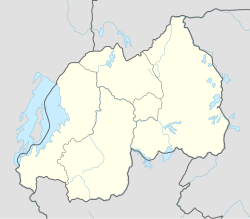Kibeho | |
|---|---|
Sector and town | |
 Panoramic view of Kibeho at Nyaruguru District | |
| Coordinates: 2°38′S29°33′E / 2.633°S 29.550°E | |
| Country | |
| Admin. Province | Southern Province |
| District | Nyaruguru |
| Area | |
| 78.54 km2 (30.32 sq mi) | |
| Population (2022 census) [1] | |
| 25,885 | |
| • Density | 329.6/km2 (853.6/sq mi) |
| • Urban | 7,641 |
Kibeho is a sector and small town in south Rwanda, which became known outside of that country because of reported apparitions of the Blessed Virgin Mary and Jesus Christ occurring between 1981 and 1989. It is also known for the Kibeho Massacre in April 1995, when several thousand internally displaced people were killed by the Rwandan Patriotic Army.


